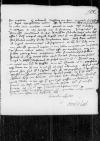Hoc cuperem, quod nuntiares orig. nunciares⌈nuntiaresnuntiares orig. nunciares⌉ ⌊Nassouio⌋ me heri locutum orig. loquutum⌈locutumlocutum orig. loquutum⌉ cum ⌊caesare⌋, qui dixit excogitatum meum esse de ⌊Maranis⌋ illos esse pauperes et nulla bona avehere. Cuius contrarium tu nosti, nam et ⌊Fochari⌋, et ⌊Welzeri⌋, et alii honesti viri id sciverunt. Indignabatur, quod informassem ⌊cancellarium⌋ et ⌊dominum de Nassau⌋ subinde quaerens, num ita esset. Respondi, antequam aliquid inciperem, verum esse me praemonuisse non eum solum, sed alios consilii privati,[1] et plurima talia. Tandem dixit auditum esse ingens emolumentum inde secuturum orig. sequuturum⌈secuturumsecuturum orig. sequuturum⌉. Ubi esset id? Respondi me non potuisse quicquam capere, cum non haberem mandata pro hac patria. In summa noluit credere multos esse, qui transierint, neque persuaderi potuit, quod bona aveherent. Velle se omnem terram suam ⌊Iudaeis⌋ spoliatam esse et, quod omnes essent apud ⌊Turcas⌋,[2] se non timere ⌊Iudaeos⌋. Magis a falsis Christianis et ⌊Iudaeis⌋ timoris esse.
Vellem itaque, ut ageres cum ⌊domino de Nassau⌋, ut in tempore convenienti, cum res poposcerit test, dicat ea, quae non a me, sed ab aliis audiverit, deinde, cum videam parum spei situm esse in ⌊caesare⌋, ipse, ubi res poposcerit, in aequissima orig. equissima⌈aequissimaaequissima orig. equissima⌉ causa me non superinscribed⌈nonnon superinscribed⌉ permittat periclitari, in quantum potest, et si potest, animum caesaris erga me leniat, cum nihil tale commiserim. Quod si potes commode, et hoc age: si qua in parte posset me adiuvare, in futurum non desit homini non malo nec infideli. Similiter, si occasio fuerit, cum ⌊cardinali⌋ age. Commendo omnia discretioni tuae. Cuperem mihi, etiam si in minimo esset, provideri in hac patria, quia cum ⌊caesare⌋ iam despondi animum.


 AAWO, AB, D. 6, f. 124v
AAWO, AB, D. 6, f. 124v